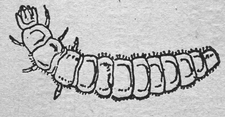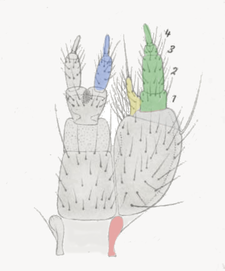Podabrus alpinus
| Podabrus alpinus | ||||||||||||
|---|---|---|---|---|---|---|---|---|---|---|---|---|
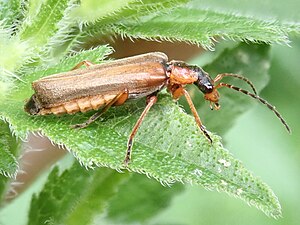
Podabrus alpinus |
||||||||||||
| Systematics | ||||||||||||
|
||||||||||||
| Scientific name | ||||||||||||
| Podabrus alpinus | ||||||||||||
| ( Paykull , 1798) |
Podabrus (Podabrus) alpinus is a beetle from the family of the soft beetles (Cantharidae) and the subfamily of the Cantharinae . The genus Podabrus isrepresentedby two species in Europe, apart from the widespread Podabrus alpinus , the species Podabrus annulatus , which radiates from the northeast,occurs. Both species also belong to the subgenus Podabrus .
Comment on the name
The species is already described by Paykull in 1798 under the name Cantharis alpina . The part of the name alpinus ( lat. Alpīnus, living on the Alps) is explained by the fact that Paykull specifies the beetle's habitat near the Alps of Dalecarlia and Lapponia .
After the genus Cantharis was split up , the beetle was divided into different genera and sub-genera by different authors ( Cantharis , Telephorus , Podabrus , Brachynotus , Malthacus ).
The generic name Podabrus appears for the first time in 1821 in the appendix Genres des insectes ( fr. Insect genera ) to Entomographia Imperii Russici - Entomographie de la Russe (lat / fr. Description of the insects of Russia ) by Fischer von Waldheim . Neither there nor in 1844 in Fischer von Waldheim's Spicilegium Entomographiae Russicae ( Latin addendum to the description of the insects of Russia ) does Fischer von Waldheim define the genus. In 1833 and 1837 Dejean adopted the generic name in the catalogs for his collection, but also without a description of the genus. That is why Westwood is considered the author who briefly characterized the genus Podabrus in a synopsis of the insects occurring in England in 1840 .
The name Pódabrus derives from Altgr. ποδαβρός podabrós off. This means weichfüßig, zartfüßig ( s. Tender-footed), but also flinkfüßig, like the wind. However, the description of the genus does not give any compelling indication of what is meant by it, possibly alludes to the weakly developed end spines of the rails.
The numerous synonyms prove the diversity of the beetle. In Fauna Europaea, twelve synonyms for the specific epithet alpina are given ( rubens , lateralis , melancholica , mocquerysi , necrophora , ruficeps , apicalis , iljini , semibrunnea , anatolica , apicenigra , falzonii ).
Properties of the beetle

|
|
| Fig. 1: Top view (photo Udo Schmidt ) | |

|
|
| Fig. 2: 1st to 5th antenna elements | |
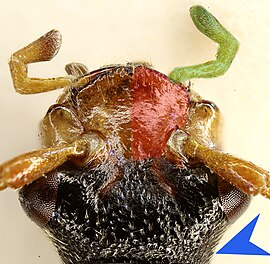
|
|
| Fig. 3: Head, right half partially colored; red: head shield, green: jaw button, arrow: constriction |
|
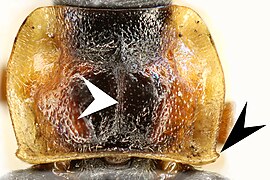
|
|
| Fig. 4: pronotum, white arrow: ridge, black arrow: posterior corner with small teeth |
|

|

|
| Fig. 5: Right hind claw from behind |
Fig. 6: Tip of the rail |
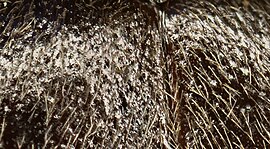
|
|
| Fig. 7: Detail of the wing cover behind the label |
|
The eleven to fourteen millimeter long beetle is unusually rich in color. As early as 1862, Mulsant described five color variants, which are mainly determined by the proportion of black in the color of the beetle. The beetle is about four times as long as it is wide at the shoulders. Legs, antennae, elytra and underside are densely hairy, the head is partially bald on top, the pronotum is only very sparsely hairy. As with all soft beetles, the body is only slightly sclerotized , the wing covers deform slightly.
The head stretched forward ( prognath ) is brown-yellow or red, sometimes with a black vertex, or completely black. It is broad and the cheeks are well developed in front of the eyes. Behind the eyes it is neck-shaped and clearly separated from the pronotum (Fig. 1 and blue arrow in Fig. 3). This neck , along with the shape of the pronotum, provides a sure sign of the genus. The back part of the head is strong, dense and slightly wrinkled punctured . The medium-sized eyes are almost hemispherical, strongly protruding and a good diameter of eye from the anterior edge of the pronotum. A flat transverse impression runs directly behind the eyes (only recognizable from the side, taxi image). The head shield (Fig. 3 right tinted red) is rounded at the front. The eleven-limbed antennae are thread-shaped and deflected in front of the eyes, their outer distance is smaller than the distance between the inner edges of the eyes (Fig. 3). The antennae are half as long as the body in the females, in the males they reach three fifths of the body length. The third antenna segment is barely longer than the second, but significantly shorter than the fourth (Fig. 2). The antennae are often slightly darkened towards the tip. There is no longitudinal bulge between the antennae. The simply pointed upper jaw (partially visible in Fig. 3 on the left in front of the head shield) is thin and curved into a sickle shape. The two lower jaws each have two thick, fleshy and hairy lobes, of which the inner one is only small and little separated from the outer one. The jaw buttons (tinted green in Fig. 3 on the right) protrude far beyond the lobes. They are four-part, the lip buttons three-part. The end links of all buttons are hatchet.
The shiny pronotum (Fig. 4) is black with a more or less wide yellow or red side border or completely brownish-yellow or red. It is approximately rectangular with strongly rounded front corners and sharp-angled rear corners that are occasionally drawn out like a forward-pointing tooth (black arrowhead in Fig. 4).
The pronotum is about one and a half times as wide as it is long. The front edge is straight or slightly outlined, and just as wide as the head with eyes, the base, on the other hand, is broad but not very deep. The base is narrow and steeply bent up, the two sides are bent up very broadly, so that a groove forms that is about a fifth of the width of the pronotum. The front edge is slightly bent up.
In the front third of the pronotum there is a flat transverse impression (easily recognizable in the taxi image). In front of it, the dots are flatter than on the head and slightly wrinkled; behind it, towards the base, they are slightly finer than on the head. Behind the transverse impression, the pronotum is pressed flat lengthways and a very fine longitudinal groove runs like a line on the bottom of this impression (white arrowhead in Fig. 4). In front of this longitudinal groove there is a teardrop-shaped bulge that tapers towards the front in the transverse impression.
The label is black and forms an approximately equilateral triangle.
The wing covers are brown-yellow or black, in the latter case they can be lined with red from the base to the middle. They are wrinkled leather-like and hairy lying shortly behind (Fig. 7). They are a good three times as long as they are wide together. The sides run almost parallel to each other, at the end they are broadly rounded together. A few ribs are indicated (Fig. 1).
The front hips protrude from the joint pits in the shape of a pin. The splints are rounded at the top, the two end spines on the back of the splints are very fine and delicate and not always easy to recognize (Fig. 6). The tarsi are five-limbed, the penultimate limb two-lobed. All claws are split, the tooth on the inside is moderately wide and pointed (Fig. 5).
There are eight rings on the abdomen in the male and seven in the female.
Larva and pupa
In the last stage, the larva becomes up to eighteen millimeters long with a width of up to three millimeters in the middle. It shows the flattened shape of a larva of the genus Cantharis (Fig. 8) and is more flattened on the underside than on the upper side. She is fleshy and coarse-skinned. It is quite thickly haired, dirty brownish yellow on the top, dirty ocher yellow on the underside, and looks velvety.
The flat head is stretched out horizontally, strongly chitinized , shiny and almost square when viewed from above . The head capsule shows no seams. The back half of the head is dark maroon, the front half is lighter. The front half of the head shows a clearly separated longitudinal depression. This ends in a tooth-shaped elevation at the front on both sides, which ends in a tuft of very short hair. The top of the head is quite densely covered with hair lying in front, slightly more hairy in front than behind.
The upper lip is fused with the head capsule. The shape of the leading edge of the head formed in this way provides characteristics for distinguishing the different species. The upper jaws are relatively strong, curved inward in the shape of a sickle and provided with very blunt, relatively small teeth in front of the center of the inner side. In the genus Cantharis this tooth is pointed. Behind the tooth towards the mouth opening runs a sluice groove . This on the one hand facilitates the choking out of digestive juices, on the other hand it supports the absorption of liquefied food. The mandibles are dark brown and blackened towards the tip.
The relatively long antennae are deflected laterally behind the mandibles. They are tripartite and light brown. The first link is cylindrical and slightly longer than the second and slightly widened towards the end. Both basic phalanx are very finely haired, the second also has a sensory papilla at the end outside next to the end phalanx, which is equipped with a few bristles protruding almost at right angles. The distal phalanx, which is inserted next to the papilla, is awl-shaped and very small, only about twice as long as the papilla. The only point eye is large, transversely oval, and sits relatively far behind the antennae on the side of the head.
On the underside of the head, in a semicircular section, sits the maxillary - labial complex with the lower lip in the middle and a lower jaw on each side of it. The lower jaw sits on the cardo (Fig. 9 red) and has an inner box ( Lacinia , Fig. 9 yellow) that is aligned in the direction of the body axis. On the inside of the lower jaw, a little below this ark, there is a thick tuft of hair. According to Verhoeff, this is possibly to be understood as a remodeling of the inner drawer, in which case the outgrowth marked in yellow would be the outer drawer ( Galea ). The lower jaw probes (Fig. 9 green) are four-part. The base link is short and thick, the following link thinner and about twice as long, the third link small. The distal phalanx is even thinner, finger-shaped and darkened at the tip. The lower lip is short, square and much wider than it is long, greatly expanded at the front edge with a two-part button at each corner. The base of the lip probe is thick and round, slightly widened towards the end, the end member is the same length and thin as the end member of the jaw probe. The lower and upper side of the lower jaw are hairy long, the lip and jaw palpations are hairy short. In the living state, the lip and jaw buttons extend equally far forward and are also clearly visible from above. Fig. 9 shows the lower lip and lower jaw of Cantharis rustica , which are almost identical in structure to the lower lip and lower jaw of Podabrus alpinus .
The first three body segments (thorax segments) each carry a pair of legs with five-limbed, pale yellow, long legs. The outside and inside of the legs are covered with bristles of unequal length. The base limb (hip) of each leg is short and thick and directed obliquely backwards. The following limb with the round handle (trochanter) is somewhat shorter and thinner, the legs are comparatively long and cylindrical and become thinner towards the splints. The rails are even longer and taper towards the tip. The phalanx is thin and very short and has a simple, tanned, pointed and slightly curved claw.
The thorax segments have a round to square, blackish-brown, blurred spot on top of each side, the center of which is usually darker due to several small dark spots. The spots of the pair of spots on the first thoracic segment are at least four times as large as the spots on the two following segments. The spot on the last breast segment often has two dark centers, the front larger and the rear smaller. On the sides there is a relatively large stigma only between the first and second breast segments.
The abdomen, which consists of ten segments, is not separated from the chest section, the structure of the first abdominal ring hardly differs from the top of the last chest section in front of it, and the chest sections are not more sclerotized than the abdominal segments. Towards the rear, the sections slowly become narrower, in particular the two end links, which are designed as follower and anal link, are narrower. The color of the abdominal segments differs from that of the chest. Over the back of the first eight abdominal segments run four parallel, lighter, multiple interrupted and partially broken up, difficult to recognize lines. Only the back of the pusher bears two irregular, three-sided, very pale blackish-brown spots next to each other and no light longitudinal lines. The first eight abdominal segments each have a small stigma on each side, all nine abdominal segments have a glandular opening on their back from which repulsive secretions are released.
The doll is fourteen millimeters long and four millimeters wide. It is pale yellow ocher with a reddish tinge. The future pronotum with rounded front corners and blunt rear corners gives an idea of the outline of the pronotum in the adult animal. The eyes of the older doll stand out as large, black-brown, translucent.
biology
In Central Europe, the beetle occurs primarily in summer at higher altitudes ( boreomontane ), it is less common on the plains. In England, for example, it is not uncommon to find it at lower altitudes and occurs as early as spring. It is not tied to a specific habitat. It can be found equally in mixed and coniferous forests, in the forest or at its edges, on tall herbaceous meadows and mats, on conifers, on bushes, or on the flowers of umbellifers . The beetles are diurnal, but males are also noticeably often caught with light traps.
Beetles and larvae are predatory. The beetles chop up the food and may also eat plant-based foods. The larvae can only eat viscous food. Beetles and larvae protect themselves against predators with repellent secretions .
The larvae used for the first description were caught in Central Europe in old, abandoned, not yet overgrown anthills in pure spruce stands and mixed stands in April. Pupation takes place in mid-May, the beetles appear at the end of May. You can move very quickly. The larvae are generally found in the soil in the upper soil layers, in the litter and in rotten wood. At eighteen to twenty degrees, the first and second larval stages last twelve to 15 days, in the first stage the larvae measure just under two to two and a half millimeters, in the second up to five millimeters. The third stage lasts about sixteen days and the larva reaches a length of seven to nine millimeters. From the fourth stage the animals are normally pigmented. The fourth stage lasts up to 25 days and the larvae become about ten millimeters long. The fifth stage lasts about 50 days and the larvae grow up to 12 millimeters long. The last larval stage lasts an average of 175 days, with the larvae reaching the full length of fourteen to seventeen millimeters. The beetles therefore have a one-year life cycle.
distribution
It is in Podabrus alpinus a widespread in central and northern Europe and Asia Art. In Europe, in the west the border runs of its range by France and Italy , to the north you will find the way to Ireland , Scotland , Norway , Sweden , Finland and the north of the European part of Russia . In the south, the limit of dispersion runs through Italy, Austria , Slovakia and Ukraine . Within Russia, the distribution area extends east to Siberia, according to one source to northwestern Siberia, and according to another to Vladivostok .
literature
- Heinz Joy, Karl Wilhelm Harde, Gustav Adolf Lohse: The beetles of Central Europe . tape 6 : Diversicornia . Spectrum, Heidelberg 1979, ISBN 3-87263-027-X , p. 21 .
- Edmund Reitter : Fauna Germanica, the beetles of the German Empire. Volume 3, KGLutz 'Verlag, Stuttgart 1911, p. 255.
- Gustav Jäger (Ed.): CG Calwer’s Käferbuch. 3. Edition. K. Thienemanns, Stuttgart 1876, p. 372.
- Klaus Koch : The Beetles of Central Europe Ecology . 1st edition. tape 2 . Goecke & Evers, Krefeld 1989, ISBN 3-87263-040-7 , pp. 31 .
Individual evidence
- ↑ a b c Podabrus alpinus from Fauna Europaea, accessed on December 6, 2018.
- ↑ a b Podabrus annulatus from Fauna Europaea, accessed on December 6, 2018.
- ^ A b Gustav Paykull: Fauna Svecica - Insecta. Volume 1, Upsala 1798, p. 259 ( Cantharis alpina ).
- ↑ Sigmund Schenkling: Explanation of the scientific beetle names (kind) .
- ↑ Gotthelf Fischer: Entomographia Imperii Russici. Volume 1, Moscow 1820-1822 part of Entomographia rutenica in the Google book search and ( Genres des insectes, p. 84/100 Podacrus ).
- ↑ G. Fischer de Waldheim: Spicilegium Entomographiae Rossicae. P. 33 ( Podabrus Fischer ).
- ^ Dejean: Catalog des Coléoptères de la Collection de M. Le Comte Dejean. Paris 1833, Deuxième édition, p. 105 ( Podabrus Fischer ) and Dejean: Catalog de la Collection de Coléoptères de M. Le Baron Dejean Paris 1837, p. 118 Podabrus Fischer in the Google book search.
- ↑ J. O. Westwood: An Introduction to the modern classification of insects. Volume 2, London 1840 Appendix Synopsis of the genera of British insects. P. 27 ( Podabrus ).
- ↑ John L. Leconde: Synopsis of the Lampyridae of Temperate North America. Read at session September 30, 1851 In: Proceedings of the Academy of Natural Sciences of Philadelphia. Volume 5, Philadelphia 1852, p. 343 ( Podabrus ).
- ↑ Sigmund Schenkling: Explanation of the scientific beetle names (genus) .
- ↑ Ancient Greek English Dictionary ποδαβρός
- ↑ Pape: Concise dictionary of the Greek language Translatum gr. P. 642
- ^ A b E. Mulsant, Histoire naturelle des coléoptères de France - Mollipennes. Volume 17, Paris 1862, p. 133 f. ( Podabrus ).
- ↑ WF Erichson et al .: Natural history of Germany's insects. Volume 4: Coleoptera. Berlin 1857, p. 496 ( as Cantharis alpine ).
- ↑ Ludwig Redtenbacher: Fauna Austriaca - The beetles. 3rd edition, 2nd volume, Vienna 1874, p. 9 ( Podabrus alpina ).
- ↑ Edmund Reitter : Fauna Germanica, the beetles of the German Empire. Volume 3, KGLutz 'Verlag, Stuttgart 1911, p. 254 (Fig. 75).
- ^ A b Carl W. Verhoeff: On the development, morphology and biology of the pre-larvae and larvae of the Cantharids. In: Archives for Natural History. 83rd year, 2nd issue, Berlin 1917, p. 102 ff ( Fig. 16 lower lip, lower jaw of the larva of Cantharis rustica ).
- ^ MG Fitton: The larvae of the British genera of Cantharidae (Coleoptera). In: Journal of Entomology Series B Taxonomy. Volume 44, No. 3, 1975.
- ↑ KW Verhoeff: On the knowledge of the Canthariden larvae 2nd contribution In: Archive for natural history. 89th year, 1st issue, Berlin 1923, p. 110 ff ( online ).
- ↑ a b Theodor Beling : Contribution to the biology of some beetles from the telephoric family. In: Berlin Entomological Journal. Volume 29, Issue 2, p. 352 ( larva of Cantharis alpina ).
- ↑ LM Medvedev, VA Pototskaya, BR Striganova: ОПРЕДЕЛИТЕЛЬ ОБИТАЮЩИХ В ПОЧВЕ ЛИЧИНОК НАСЕКОМЫХ ( Identification key for larvae living in the soil) ACADEMY OF THE SCIENCES OF THE UDSSORIAN INSTITUTE. TO SEVERTSOVA, Moscow 1964.
- ↑ Noël Magis: Sur les Malacodermes palaearctiques 36 - 40. In: Bulletin et annales de la Société royale d'entomologie de Belgique. Volume 104, 1968, p. 153 ( PDF ).
- ↑ Е.В. Турис: РЕЗУЛЬТАТИ ДОСЛІДЖЕНЬ БІОЛОГІЇ М'ЯКОТІЛОК (CANTHARIDAE, COLEOPTERA) (ПОВІДОМЛЕННЯ 2). In: Entomologia. Scientific Herald of Uzhhorod University Biology Series, Issue 20, 2007, pp. 156-168 ( PDF ).
- ↑ Sergey V. Kazantsev An annotated checklist of Cantharoidea (Coleoptera) of Russia and adjacent territories. In: Russian Entomol. Volume 20, No. 4, pp. 387-410 (p. 393) ( PDF ).
- ^ Adolf Horion : Faunistics of the Central European Beetles. Volume 3: Malacodermata, Sternoxia. Special volume of the entomological work Museum G. Frey, Munich 1953, p. 13 ( online ).
